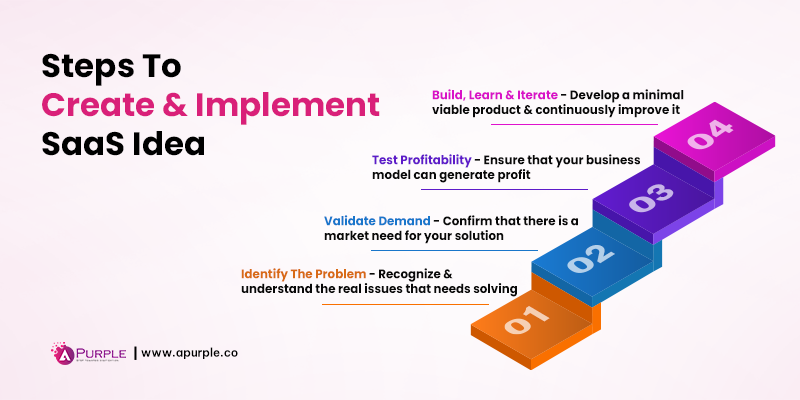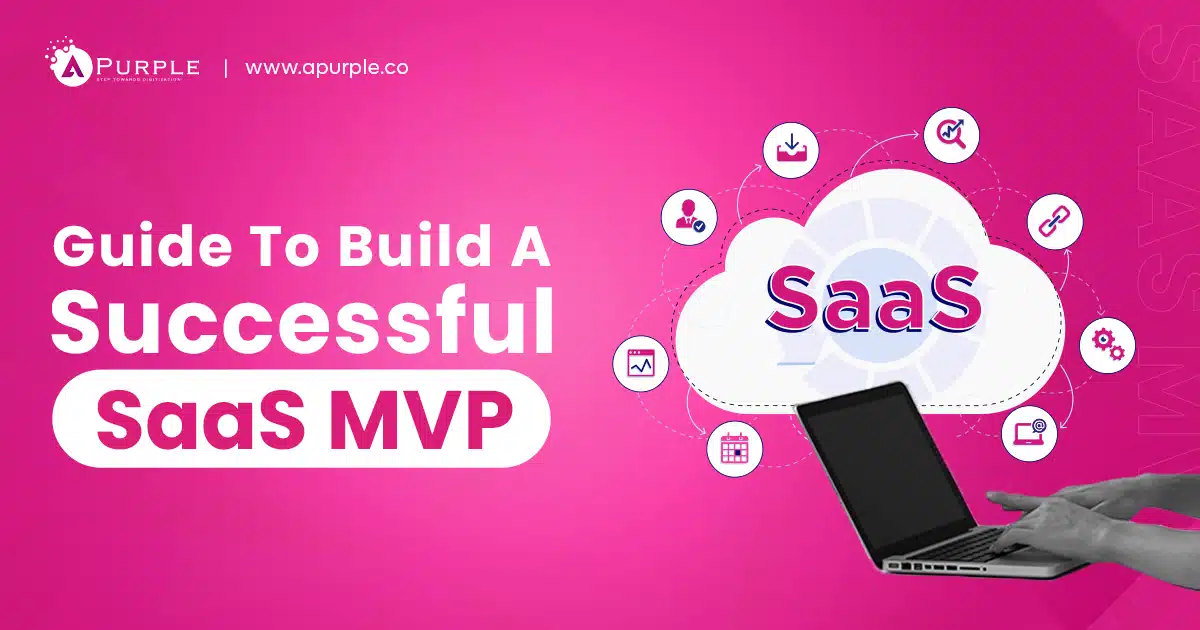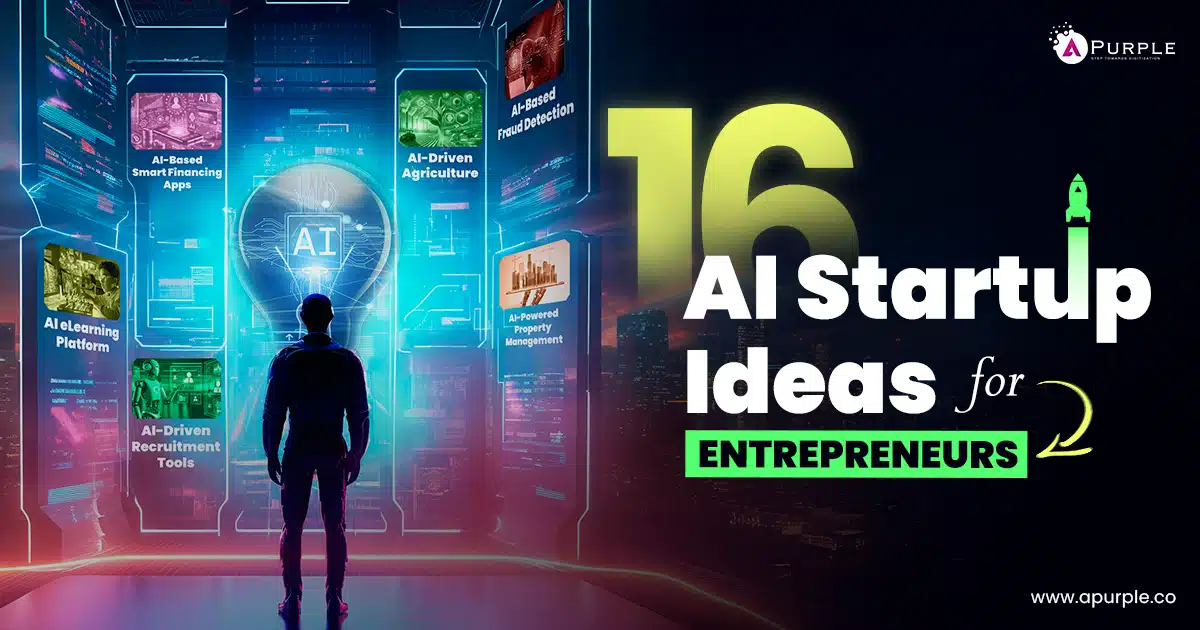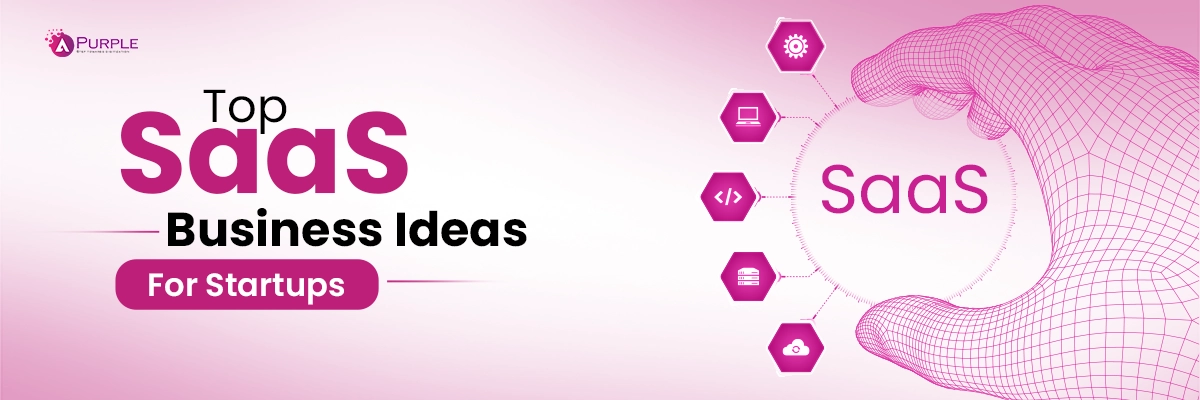
Most SaaS ideas fail!
And not because they lack potential, but because they chase noise instead of solving real problems.
This guide cuts through the noise.
It offers 15 SaaS business ideas that are not only backed by market demand and solid revenue models but are built for an AI-first ecosystem.
Whether you’re building your first product or planning to enter a new market, these SaaS ideas offer real opportunities with improved ROI.
What Are The Top SaaS Business Ideas To Invest In 2026?
Here are some of the best SaaS startup ideas that you can use for your business.
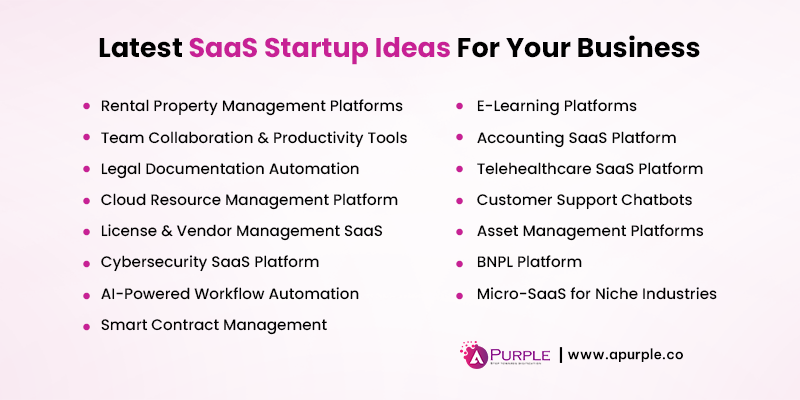
- 1. Rental Property Management Platforms
- 2. Team Collaboration & Productivity Tools
- 3. Legal Documentation Automation
- 4. Cloud Resource Management Platform
- 5. License & Vendor Management SaaS
- 6. Cybersecurity SaaS Platform
- 7. AI-Powered Workflow Automation
- 8. E-Learning Platforms
- 9. Accounting SaaS Platform
- 10. Telehealthcare SaaS Platform
- 11. Customer Support Chatbots
- 12. Asset Management Platforms
- 13. BNPL Platform
- 14. Micro-SaaS for Niche Industries
- 15. Smart Contract Management
1. Rental Property Management Platforms
Rapid urbanization and increased investments in rental properties have led to a surge in demand for rental property bookings. Rental property management firms face legal compliance, tenant screening, and lease agreement complexities.
If you are an entrepreneur, building a platform that can address the challenges of rental property management can be one of the most profitable SaaS application ideas.
Here are the crucial reasons why it is one of the best SaaS ideas to consider.
- Market Potential – The Global property management software market is projected to reach a revenue of $ 8,041 million by 2030, growing at a CAGR of 8.1% between 2024 and 2030.
- Target Audience – If you plan to build this software as a service, your target audience will be landlords, property managers, and real estate agencies.
- Revenue Model – You can charge landlords, property owners, or estate agencies a subscription fee per property for the use of the software. Plus, you can also charge transaction fees for rental bookings. For premium features like tenant screening or AI-based accounting, you can charge a higher fee.
- Key Competitors – Some of the key competitors in the rental property management SaaS market include Buildium, AppFolio, and Rentec Direct.
Some of the key features of rental property management SaaS are,
- Online rent collection and automated invoicing
- Tenant and lease management
- Document storage and management
- AI-powered chatbots and support
- Automated tenant screening
What Will The Impact of AI Be On Rental Property Management?
2. Team Collaboration & Productivity Tools
The shift towards hybrid work, coupled with the need for seamless cross-functional communication, is driving the demand for team collaboration and productivity platforms. Modern organizations face challenges of maintaining project visibility, facilitating real-time communication, and automating workflows.
A SaaS-based team collaboration tool can empower businesses to overcome these hurdles and enhance operational efficiency. If you are an entrepreneur seeking a high-impact venture, building a team collaboration and productivity platform is one of the most promising SaaS application ideas.
Here are the crucial reasons why this is a top SaaS opportunity to consider.
- Market Potential – The global team collaboration software market is projected to reach $60.38 billion in revenue by 2032, growing at a CAGR of 11.9% between 2024 and 2032.
- Target Audience – The primary users for such a platform are SMBs, large enterprises, project managers, and distributed teams. These groups often struggle with fragmented communication, a lack of transparency in project progress, and inefficient task management.
- Revenue Model – You can implement a tiered subscription model based on team size, feature access, and storage capacity.
- Key Competitors – Major players in the team collaboration SaaS space include Slack, Microsoft Teams, and Asana. These platforms set the standard for real-time messaging, project tracking, and integration ecosystems.
Some of the key features of team collaboration and productivity SaaS are:
- Real-time messaging and video conferencing
- Task and project management
- File sharing and document collaboration
- Automated workflow management
- Advanced reporting and analytics
- Customizable notifications and reminders
How Is AI Boosting Productivity And Collaboration?
3. Legal Documentation Automation
The increasing complexity of legal workflows and the demand for speed have driven a surge in the adoption of legal document automation platforms. Law firms, corporate legal departments, and government agencies face mounting challenges with regulatory compliance, contract management, and high-volume document processing.
You can develop a legal document automation solution to help these organizations streamline their operations, reduce errors, and enhance productivity.
Here are the crucial reasons why this is a top saas startup idea.
- Market Potential – The global legal document automation software market is estimated at $13.02 billion by 2026 and is projected to reach approximately $6 billion by 2033, with a CAGR of 15%.
- Target Audience – If you create a platform based on this SaaS application idea, your target audience will be law firms, in-house legal departments, and small to medium-sized enterprises.
- Revenue Model – You can leverage a subscription-based pricing model for access to the platform. Additionally, you can introduce a pay-per-use model, where law firms pay a fee per document processed. Lastly, you can leverage a freemium model, where premium features, such as analytics and automation, are offered for a fee.
- Key Competitors – Some of the major players in this SaaS business idea are Formstack, Clio, Templafy, and LegalZoom.
Key features of such platforms are,
- Automated document drafting and assembly
- AI-powered clause suggestions and contract analysis
- E-signature integration
- Template management and version control
- Cloud-based collaboration.
- Integration with practice management and CLM systems
How AI Automates Legal Documentation?
4. Cloud Resource Management Platform
Cloud resources are at the core of operations across industries. From logistics to healthcare, cloud resources enable businesses to scale their operations effortlessly. The rapid adoption of AI is also driving demand for cloud resource management.
With an effective cloud resource platform, companies can easily manage their resources and optimize costs. You can leverage this saas startup idea to create a platform that optimizes cloud resources and reduces operational costs for businesses.
Here are the crucial reasons why this is one of the best SaaS startup ideas.
- Market Potential – The cloud management platform market is set to reach $46.26 billion in 2029, growing at a CAGR of 21.4%.
- Target Audience – Your target audience will be small and medium-sized enterprises looking to overcome the challenges of fragmented resource management, escalating costs, and the need for unified oversight and security.
- Revenue Model -You can charge companies a recurring fee for access to specific features or the entire platform. Additionally, tiered pricing for the platform also generates higher revenue.
- Key Competitors – Major players in this market are AWS, IBM Cloud, DigitalOcean, and Azure Arc.
Key features of cloud management platforms are,
- Resource provisioning and management
- Cost management and optimization
- Performance monitoring and observability
- Automation and orchestration
- Security and compliance management
How AI Helps Manage Cloud Resources Optimally?
5. License & Vendor Management SaaS
The rapid growth of digital transformation and cloud-based applications has made licensing and vendor management complex. Companies must track software licenses from various vendors, ensure compliance, optimize costs, and reduce risks.
A SaaS-based license and vendor management platform provides centralized oversight, streamlines compliance, and enhances operational efficiency. It is also one of the best B2B SaaS startup ideas that entrepreneurs can leverage to offer managed licensing services.
Here are the key reasons to consider.
- Market Potential – The global license management market is projected to reach $10.16 billionby 2032, growing at a CAGR of 10.4% from 2026 to 2032.
- Target Audience – If you plan to build such a platform, your target audience will likely be large enterprises, SMEs, IT departments, procurement teams, and managed service providers.
- Revenue Model – You can use a tiered subscription model based on the number of managed licenses, vendors, users, and advanced features.
- Key Competitors – Some of the major competitors you may face in this SaaS market are SAP Ariba, Coupa, and GEP.
Key features of license and vendor management platforms are,
- License Inventory Management
- Usage Tracking and Metering
- Compliance Monitoring
- Automated Alerts and Renewals
- Vendor Management
- Workflow Automation
- Scalability and Customization
- Payment and Contract Management
How AI Helps Manage Vendors And Licences?
6. Cybersecurity SaaS Platform
Global spending on cybercrime is set to reach $23 trillion by 2027. A surge in the cost of cybercrime is driving the demand for SaaS platforms that combat cybercrime. It is also one of the software-as-a-service business ideas that startup owners can use to help organizations overcome security risks.
Such a platform provides data protection for sensitive information and against threats like ransomware, phishing, and data breaches. Creating such a platform can also be a profitable opportunity for entrepreneurs. However, you need to consider the following aspects.
- Market Potential – The global Security-as-a-Service market is projected to grow from $16.4 billion in 2025 to $45.4 billion by 2032, at a robust CAGR of 15.7%
- Target Audience – Your target audience will be enterprises, SMEs, government agencies, and managed security service providers.
- Revenue Model – You can use a pay-as-you-go or tiered subscription model, which is standard, allowing customers to pay for only the services and capacity they need. Additional revenue streams include premium charges for advanced threat intelligence, AI-powered analytics, compliance modules, and 24/7 incident response. Enterprise clients may incur extra costs for custom integrations, onboarding, and dedicated support.
- Key Competitors – Major players in the cybersecurity SaaS market include Google, Cisco Systems, McAfee, Symantec, Microsoft, Amazon, IBM, and Trend Micro.
Key features of cybersecurity SaaS platforms are,
- Identity and Access Management (IAM)
- Data Encryption
- Threat Detection and Response
- Security Information and Event Management (SIEM)
- API Security
- Cloud Access Security Broker (CASB)
- Endpoint Detection and Response (EDR)
- Vulnerability Management
- Compliance Management
- Backup and Disaster Recovery
What Will Be The Impact Of AI On Cybersecurity Management?
7. AI-Powered Workflow Automation
The rapid digital transformation across industries has driven demand for seamless workflow automation. Organizations face challenges such as isolated processes and manual task dependencies. Developing an AI-driven workflow automation SaaS platform is one of the software-as-a-service ideas that can help organizations overcome these challenges.
- Market Potential – The global workflow automation market is projected to grow at a CAGR of 10.09% and is expected to reach $48.31 billion in revenue by 2032.
- Target Audience -Your primary target audience includes IT departments, operations teams, HR, finance, and customer support divisions.
- Revenue Model – You can charge a tier-based subscription fee for access to the platform. Additionally, you can offer premium modules for advanced analytics, custom integrations, and dedicated AI-powered process optimization at higher rates.
- Key Competitors – Major competitors that you may encounter when implementing this SaaS business idea include UiPath, Zapier, Workato, and Microsoft Power Automate.
Key features of the Workflow Automation SaaS Platform,
- Drag-And-Drop Workflow Builder
- AI-driven Process Optimization
- Integration Wth Third-Party Applications
- Automated Notifications and Escalations to ensure timely task completion
- Role-Based Access Controls (RBAC)
- Intelligent Document Processing
How AI Helps Automate Workflows?
8. E-Learning Platforms
The demand for e-learning platforms has increased in tandem with the rise in internet usage and the growing popularity of online education. This demand is fueled by the need for flexible, scalable, and interactive solutions to upskill, reskill, and deliver knowledge efficiently. Building a robust e-learning platform that addresses the evolving needs of modern learners is one of the key profitable SaaS ideas.
Here are the crucial reasons why this is one of the best SaaS ideas to consider.
- Market Potential – The global e-learning market is projected to reach over $1515.97 billion by 2033, with a CAGR exceeding 17.35% between 2024 and 2030.
- Target Audience – Your primary users will include educational institutions (such as schools, colleges, and universities), corporate Learning and Development (L&D) teams, training providers, and individual learners seeking self-paced courses. Each segment requires tailored features, from classroom management to certification tracking.
- Revenue Model – You can leverage tiered subscriptions for SaaS platform accessibility based on specific roles, such as instructors, learners, and admins. Additionally, consider the course volume and charge for advanced features, such as analytics or integrations.
- Key Competitors – Leading platforms in the e-learning SaaS space include Coursera, Udemy, Moodle, and Teachable.
Some of the key features of an e-learning SaaS platform are:
- Course Creation and Management
- Learning Paths and Progress Tracking
- Live and On-Demand Sessions
- Assessment and Certification
- Collaboration Tools
- AI-Powered Personalization
- Integration Capabilities
- Mobile Accessibility
What Will The Impact Of AI Be On Learning Outcomes?
9. Accounting SaaS Platform
Managing finances is one of the most significant pain points for startups and growing businesses. Manual bookkeeping, complex compliance rules, and scattered financial data often slow teams down and lead to costly mistakes. An accounting SaaS platform solves these challenges by making accounting simple, automated, and accessible from anywhere.
If you’re a founder looking for a proven SaaS idea, building an accounting platform can help you tap into a massive and evergreen market.
Why this is a top SaaS startup opportunity:
- Market Potential – The global accounting software market will reach $31.25 billion in revenue by 2030, growing steadily at a CAGR of 8.4%.
- Target Audience – Your target audience will be small businesses, accountants, and finance teams who want to automate tasks, reduce errors, and get instant financial insights.
- Revenue Model – You can use a tiered subscription model based on business size and feature needs. Upsell advanced analytics, integrations, or compliance modules for extra revenue.
- Key Competitors – QuickBooks Online, Xero, FreshBooks, and Sage are the big names, but there’s plenty of room for innovation in user experience, automation, and integrations
Must-have features for your accounting SaaS platform:
- Automated Bookkeeping And Invoicing
- Real-time Expense Tracking
- Instant Financial Dashboards
- Tax Compliance Tools
- Multi-Currency And Global Tax Support
- AI-powered fraud and anomaly alerts
- Integrations with payroll, CRM, and ERP systems
How AI Automates Accounting?
10. Telehealthcare SaaS Platform
Telehealth SaaS platform offers a cloud-based solution for healthcare providers to offer remote consultations and patient care. Using a telehealth platform, patients can access virtual care, remote monitoring, and real-time consultations on their terms.
This reduces long wait times for patients, addresses a shortage of specialists, and alleviates the burdens of in-person visits. Telehealthcare platforms are also one of the best SaaS business ideas that you can leverage as an entrepreneur. It caters to a massive market, which you can capitalize on by consulting with startup experts.
Some of the key aspects of this SaaS business idea that you must know are,
- Market Potential – The global telehealth market is projected to grow up to $85 billion in revenue by 2030, with a CAGR of 22.06%.
- Target Audience – The target audience for this software-as-a-service business idea will be healthcare providers, clinics, hospitals, insurers, and direct-to-patient models.
- Revenue Model – You can charge commissions on per-consultation fees and premium add-ons, such as AI diagnostics or integration with wearable devices.
- Key Competitors – Teladoc Health, Amwell, and Philips are the major leaders in this market.
Key features of the telehealth platform:
- Video Consultations
- Remote Patient Monitoring
- AI-Powered Triage and Diagnostic
- Appointment Scheduling
- EHR Integration
- HIPAA And GDPR Compliance
How AI Transforms Healthcare?
11. Customer Support Chatbots
The advent of artificial intelligence has revolutionized the way customer support services operate. By leveraging the natural language processing capabilities of AI chatbots, support services are becoming increasingly efficient through more personalized customer interactions.
AI-based chatbots are addressing key challenges faced by customer-facing businesses. Startups can offer customized chatbots that companies can integrate into their existing systems for personalized communication.
Some of the key aspects of this SaaS business idea that you must know are,
- Market Potential – The AI chatbot market is set to reach $66.6 billion in revenue by 2033, growing at a CAGR of 26.4%.
- Target Audience – Your target audience will primarily consist of e-commerce brands, SaaS companies, banks, telecoms, and any business with a digital presence that seeks to automate customer support.
- Revenue Model -You can either charge a subscription fee or pay-per-use based on conversation volume, number of agents, or advanced features like multilingual support and analytics.
- Key Competitors – Zendesk, Intercom, Drift, and Freshchat are established players, but there’s space for startups to enter the market, creating specialized solutions, deeper AI capabilities, and seamless integration.
Key features of the customer support chatbots:
- AI-Powered Conversations
- 24/7 Automated Support
- Seamless Handoff To Human Agents
- CRM, eCommerce, and Helpdesk Integration
- Multilingual And Omnichannel Support
- Customizable Conversation Flows
- Data Analytics Dashboard
What Will The Impact Of AI Be On Customer Service Systems?
12. Asset Management Platforms
Asset management platforms are SaaS-based digital tools that help organizations track, manage, and optimize their assets, which can be physical or digital in nature. These assets include equipment, machinery, and other physical items, as well as software licenses, computers, and servers.
With such a broad spectrum of businesses seeking to manage their assets, this presents an opportunity for you to capitalize on as an entrepreneur. Leveraging SaaS application development you build a scalable and agile platform for asset management.
Here are some key considerations if you choose this SaaS application idea.
- Market Potential – The Asset management platform market worldwide is set to reach $26.41 billion by 2030, growing at a CAGR of 8.4%.
- Target Audience – Your target audience for this SaaS business idea will be enterprises, SMBs, healthcare, logistics, retail, manufacturing, and IT teams.
- Revenue Model – You can offer advanced capabilities like predictive maintenance and AI analytics on a subscription with a specific charge.
- Key Competitors – IBM Maximo, SAP EAM, Asset Panda, and ManageEngine lead the asset management platform market.
Key features of the customer support chatbots:
- Real-Time Asset Tracking With IoT, RFID, or GPS
- Automated Maintenance Scheduling
- Asset Lifecycle Management
- Predictive Analytics For Repairs
- ERP And CRM Integrations
- Compliance And Regulatory Reporting Tools
How AI Helps Manage Assets?
13. BNPL Platform
Buy now, pay later is a type of SaaS platform that offers instant credit to users when they want to make a purchase but don’t have sufficient financial resources. Traditional credit options are slow and often intimidating, while eCommerce brands need ways to boost conversions and average order value.
A BNPL SaaS platform bridges these gaps, offering shoppers easy, interest-free installment plans and providing merchants with a powerful tool to drive sales. If you’re a founder eyeing the fintech space, building a BNPL platform is a high-growth SaaS opportunity with global appeal.
Why this is a top SaaS startup opportunity:
- Market Potential – The global BNPL platforms market is projected to$911.8 billion by the end of 2030, growing at a CAGR of 10.2%.
- Target Audience – Ideal customers for your SaaS business idea of building a BNPL platform will be eCommerce retailers, D2C brands, marketplaces, and even offline merchants.
- Revenue Model – You can charge merchants a transaction fee (often a percentage plus a flat fee per sale), collect late payments from customers, and partner with banks for shared interest revenue on long-term plans.
- Key Competitors – Klarna, Afterpay, Affirm, PayPal Pay in 4, Sezzle, and Zip are leading SaaS-based BNPL platforms you will compete with.
Must-have features for your BNPL SaaS platform are:
- Instant Credit Scoring
- Real-Time Credit Approval
- Flexible Installment Scheduling
- AI-powered Fraud Detection
- Automated Reminders And Late Fee Management
- Merchant Dashboards With Data Analytics
- Customizable UX To Match Merchant Branding
- Regulatory Compliance (PCI DSS, GDPR, local lending laws)
How AI Enables Smart BNPL?
14. Micro-SaaS for Niche Industries
Micro-SaaS for niche industries refers to specialized platforms designed to solve specific problems within a narrow market segment. Such platforms focus on catering to the unique needs of an industry or its sub-segments.
For example, a pet food delivery platform is one such niche-based SaaS platform that entrepreneurs can develop. While it’s a broader market, investing in such micro saas ideas in 2026 makes sense, as there are many ways to generate revenue.
Here is everything you need to consider for such software-as-a-service business ideas.
- Market Potential – The global SaaS market is projected to reach $1.25 trillion by 2034, growing at a compound annual growth rate (CAGR) of approximately 13%.
- Target Audience – Your target audience will vary based on the niche you choose. For example, if you build a micro-SaaS eCommerce marketplace for antique jewelry, your target audience will likely be jewelry collectors, vintage fashion enthusiasts, and enthusiasts of historical artifacts.
- Revenue Model – This will also depend on the niche you choose. It can be a subscription to a specific service or a pay-as-you-go model.
- Key Competitors – Your key competitors will include other micro-SaaS solutions addressing the same problems, as well as larger SaaS players.
Key features of micro-SaaS niche platforms can be,
- Specific Task Automation
- AI-Based Data Analytics
- Third-Party Integrations
- Workflow Enhancement
How AI Transforms Micro-SaaS Platforms?
15. Smart Contract Management
Smart contract management platforms are key SaaS application examples that help businesses manage the entire contract lifecycle. They leverage smart contracts to manage the execution of key organizational contracts decentralized through Blockchain. Using this SaaS business idea as an entrepreneur, you can build a platform that automates the execution of contracts across operations.
Here are some key considerations for this SaaS startup idea,
- Market Potential – The Smart contract market is set to reach $12.07 billion by 2032 growing at a CAGR of 23.9%.
- Target Audience – Your core users will include legal departments, procurement teams, real estate operators, insurers, logistics firms, and enterprises that deploy blockchain-based workflows.
- Revenue Model – Implement a tiered subscription model based on contract volume, number of users, or advanced automation features. For industries with high regulatory demands or complex contract structures, offer premium modules.
- Key Competitors – Notable SaaS players and emerging startups include OpenLaw, Clause, Agrello, and Juro.
Essential features of a smart contract management SaaS platform:
- Automated Smart Contract Creation
- Digital & Cryptographic Signatures
- Contract Lifecycle Management
- Audit Trail And Version Control
- Automated Execution And Orchestration
How AI Helps Manage Smart Contracts?
The above list provides some of the best SaaS business ideas. However, as an entrepreneur, you have many more startup SaaS ideas to explore for your ventures. Here’s how to find good SaaS ideas.
How to Create SaaS Business Ideas For Your Startup?
To create SaaS business ideas for your startup in 2026, follow a structured approach that combines identification, market research, and modern tech trends.
Here are some key steps to follow,
1. Identify The Real Problems
The best SaaS business ideas often emerge from everyday struggles. Consider the bottlenecks, annoyances, or time-consuming tasks you or your team encounter regularly. If it drives you up the wall, chances are it’s frustrating hundreds (or thousands) of others, too.
Ask yourself:
- What part of your workflow makes you say, “There has to be a better way”?
- What do your teammates vent about on Slack or over coffee?
- Where are you still stuck using spreadsheets, patchwork tools, or manual workarounds?
Use the data to identify the problems and then find solutions.
2. Validate Market Demand
Research forums and industry groups. Look for frequently discussed frustrations or challenges that are commonly shared among individuals.
- Analyze existing solutions: Are they too expensive, outdated, or missing core features?
- Estimate market size: Is the group facing this problem substantial enough to make the business viable?
3. Test for Profitability
Research pricing models by examining competitors to determine what customers typically pay for similar products or services.
- Check market saturation versus opportunity: Niche, underserved markets tend to offer the best entry point for new SaaS startups.
- Recurring revenue: Plan for subscription-based billing, both businesses and investors favor monthly/annual plans.
4. Build Lean, Iterate Quickly
Build a SaaS minimum viable product(MVP) first and test the waters. Focus on one critical feature that provides tangible results and immediate value. Quickly channel real user input into your product roadmap. Iterate and expand based on actual user needs, not assumptions.
Final Thoughts
SaaS-based startups are transforming operations across various industries, addressing the specific challenges of their customers. Rising demand for different SaaS platforms and higher market potential are driving many entrepreneurs to rethink startup strategies.
The above provides SaaS application ideas that you can leverage as a founder to build a successful startup. However, creating a SaaS app requires identifying the problem you want to solve, testing demand, validating the idea, and developing the application strategically.
You need end-to-end SaaS development services for strategic roadmap design and development of such platforms. Leveraging customized solutions developed by a leading startup app development agency like aPurple, you can convert SaaS ideas into a profitable business. If you have an idea and want to build a SaaS-based platform, please contact us.
FAQs

